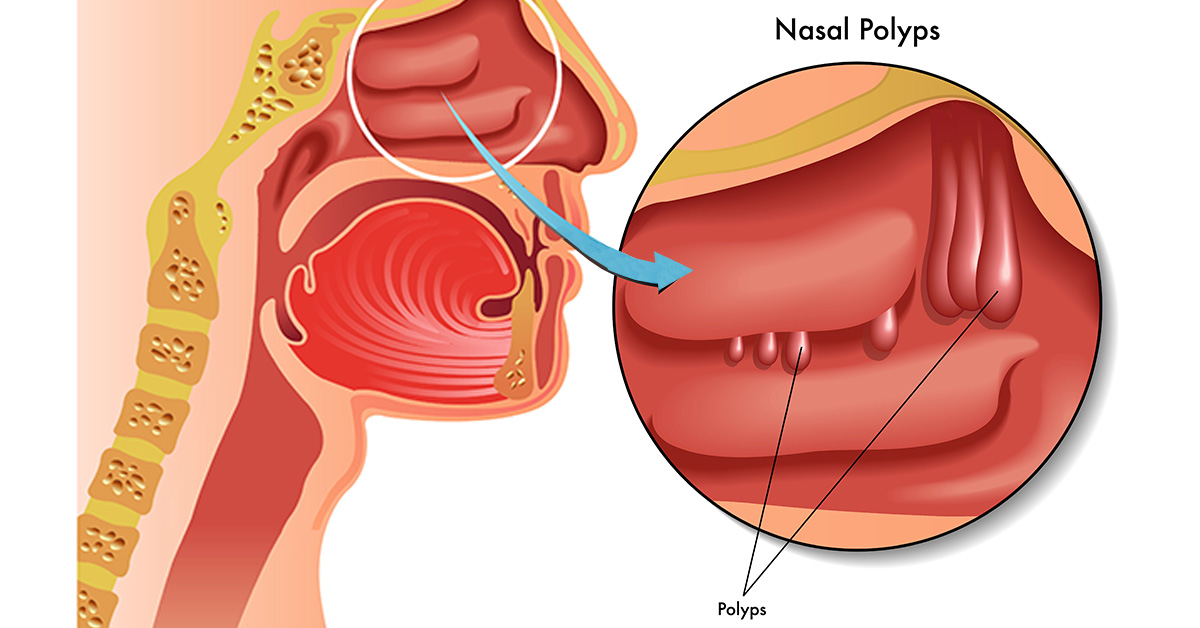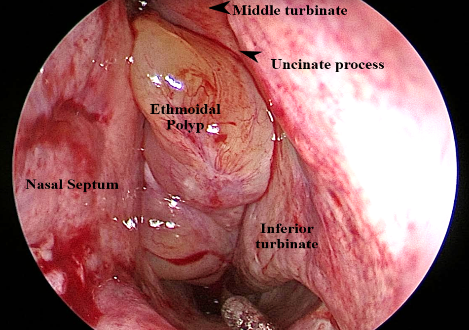
ETHMOIDAL POLYPS
Definition: Ethmoidal polyps are multiple, bilateral, painless, pearly white, grape like masses arising from the ethmoidal air cells.
Aetiology:
-
- Age: Common in adults.
- Sex: Both sexes are affected.
- Allergy: Usually allergic origin.
- Chronic rhinosinusitis.
- Asthma.
- Aspirin intolerance.
- Cystic fibrosis.
- Allergic fungal sinusitis.
- Kartagener’s syndrome.
- Young syndrome.
- Churg–Strauss syndrome.
- Nasal mastocytosis: It is a form of chronic rhinitis in which nasal mucosa is infiltrated with mast cells but few eosinophils.
Pathology:
In early stages, nasal polyp is covered by ciliated columnar epithelium like that of normal nasal mucosa but later it converts to transitional and squamous type on exposure to atmospheric irritants. Submucosa shows large intercellular spaces filled with serous fluid. There is also infiltration with eosinophils and round cells. These polyps are multiple, bilateral and have a grape like appearance. They have a strong allergic co-relation.
Site of origin:
Multiple nasal polyps arise from the lateral wall of nose. These includes:
- Middle meatus.
- Uncinate process.
- Bulla ethmoidalis.
- Ostia of sinuses.
- Medial surface and edge of middle turbinate.

Symptoms:
- Nasal obstruction: This is usually bilateral.
- Anosmia.
- Watery nasal discharge.
- Headache also called “Vacuum Headache”.
- Epiphora due to blockage of nasolacrimal duct.
- Sneezing is common as these polyps are allergic in origin.
- Hyponasal voice (Rhinolalia Clausa) is present due to bilateral nasal obstruction.
- Broadening of nasal bridge.
- X-ray paranasal sinuses: They help in detecting the extent of the disease in the sinuses.
- CT Scan of paranasal Sinuses: This is the investigation of choice. A CT Scan reveals the extent of the disease, the condition of lamina papyracea and also the posterior ethmoidal air cells and the involvement of the cribriform plate.

Treatment:
Treatment can be divided into medical and surgical and it aims to:
- Eliminate symptoms and nasal polyps.
- Re-establish nasal breathing and olfaction.
- Prevent recurrence and improve quality of life.
- Medical treatment consists mainly of topical and systemic corticosteroids.
➣ It affects eosinophil function directly by reducing both eosinophil viability and activation and indirectly by reducing the secretion of chemotactic cytokines by nasal mucosa and polyp epithelial cells.
➣ The effect of nasal spray on sense of smell is poor when compared to systemic steroids, which may be due to the sprays being unable to reach the olfactory mucosa because of oedema.
➣ Nasal drops are more effective than sprays and have a significant positive effect on sense of smell.
➣ Topical steroids may be used but not more than 2 months at one time unless under specialist supervision or for not longer than 4 months in one 12-month period, as they can be absorbed systemically.
➣ Larger polyps may require systemic corticosteroids like prednisolone 0.5 mg/kg each morning for 5–10 days. Maintenance therapy with topical corticosteroid spray is recommended as these may have lower bioavailability than drops. - Antihistamines can be given to control allergy.
- Leukotriene inhibitors help patients with coexisting asthma and/or aspirin sensitivity.
- Antibiotics- A 3-month course of a macrolide antibiotic can be given. Macrolides have been shown to increase mucociliary transport, reduce goblet cell secretions and cause accelerated apoptosis of neutrophils, all of which would reduce the symptoms of chronic inflammation. However, acute cardiac toxicity is an increasingly recognized potential adverse effect.
Surgical Management
Functional Endoscopic Sinus Surgery
➣ It is the treatment of choice and can be done along with microdebrider (microshaver).
➣ Aims to improve sinus ventilation and drainage as well as removing polyps.
➣ The extent of surgery varies with the extent of disease. Coblation can be used with microdebrider to remove the polyps from nasal cavity. The microshaver has different angled blades that have access in difficult areas of the sinuses.
➣ Postoperatively, patients should be treated with nasal douching and intranasal or systemic corticosteroids.
➣ Surgery mainly aims at opening the sinus mucociliary clearance pathways. Medical management of allergic rhinitis and regular follow up is crucial to diagnose and reduce recurrence rates.
➣ It is the treatment of choice and can be done along with microdebrider (microshaver).
➣ Aims to improve sinus ventilation and drainage as well as removing polyps.
➣ The extent of surgery varies with the extent of disease. Coblation can be used with microdebrider to remove the polyps from nasal cavity. The microshaver has different angled blades that have access in difficult areas of the sinuses.
➣ Postoperatively, patients should be treated with nasal douching and intranasal or systemic corticosteroids.
➣ Surgery mainly aims at opening the sinus mucociliary clearance pathways. Medical management of allergic rhinitis and regular follow up is crucial to diagnose and reduce recurrence rates.
We Are Always Ready to Help You.
Book An Appointment

